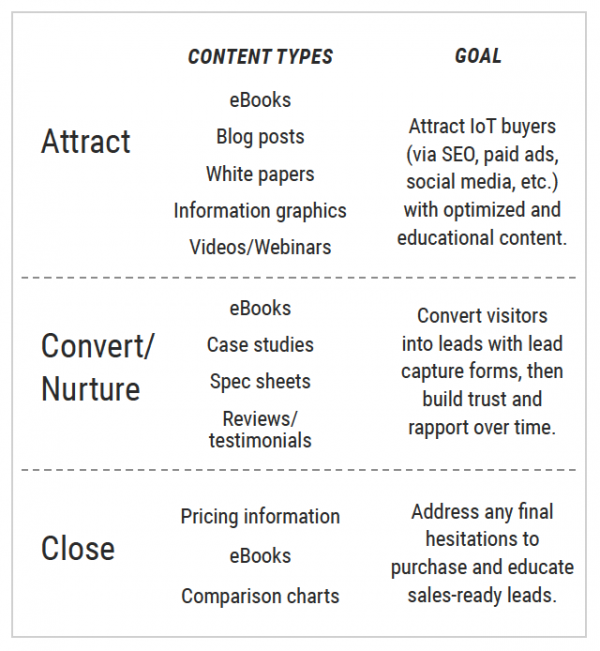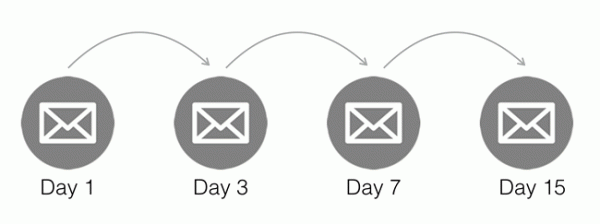
Lead nurturing is essential for every company who seeks to expand the number of sales opportunities in their sales pipeline. Especially for B2B companies, who confront longer stages cycles with a group buying decision, it’s important to establish a robust nurturing strategy to improve sales outcomes. For example, those who measure their campaigns see a 20 – 30% better response rate to nurture campaigns compared to non-nurtures (Demand Gen Report), which means companies should invest in a sound strategy. Investments in lead nurturing pay off.

The process can be overwhelming at times, especially for marketers not used to the sales process or salespeople not used to using content to nurture. However, if B2B marketing and sales teams work together with a lot of communication, lead nurturing can be very successful.
The sales funnel, or buyer’s journey, is typically organized into three stages: Awareness, Consideration, and Decision. In this blog, we’ll discuss how to move a prospect from ‘Awareness’ to ‘Consideration.’
When in the awareness stage, the buyer is trying to solve a particular problem or meet a need. It’s important to remember at this phase, the prospect may not even fully understand the problem, so it’s not the time for a company sales push. Here are some tips on how to move the lead down the funnel.

Different types of people will land on your website or landing page when trying to solve their problem. Some of these prospects will be technologically-savvy, understanding every detail of your B2B product; others, however, will be non-technical and not even fully grasp all aspects of the problem they are trying to solve. So how do you appeal to both of these audiences? By segmenting them into different groups.
By segmenting the prospects, you’ll be able to offer a more personalized experience to each group. Furthermore, this process isn’t as painful as it may seem if you use marketing automation tools. You can also consider segmenting those who downloaded your white paper versus those who filled out a submission form, for example. Either way, segment the prospects first in order to offer a more unique experience.
Now that the groups are made, it’s time to learn more about them. A buyer persona gives a more in-depth look at who might possibly purchase your product or service, and, more importantly, it helps marketers create better content that appeals to this group. Using information such as buyer role, company industry, behavioral data, demographics, buyer need, etc., create several buyer personas. As you gather more information the different segments, evolve the personas to develop a more detailed look.
Be sure to address:
Sales nurturing will be easier, at scale, when buyer needs are clear, documented, and discussed.
Content at the awareness stage always should center around making the buyer more aware of their need or problem. This is never the time to educate on your solution -- the buyer just isn’t there quite yet. Unfortunately, 65% of marketers are still challenged when it comes to understanding which types of content are effective and which types aren’t (TopRank Blog). This means that marketers are throwing content at buyers without knowing whether or not the content converts. A more useful tactic is matching content to the stage in the funnel and to the buyer persona.
 Content offers can help you throughout the entire sales funnel, especially when targeting specific stakeholders in the sales process.
Content offers can help you throughout the entire sales funnel, especially when targeting specific stakeholders in the sales process.
Good content at this level adds value to the buyer and can take the form of blog posts, social media, infographics, courses, webinars, eBooks, certifications, videos, etc. If the lead finds your content helpful, they may continue down the sales funnel. Just remember that no matter what form the content takes, it must be high-value to the prospect. Offering the lead valuable content should then push them down the sales funnel to the consideration process. From there, a whole new strategy takes shape.
65% of marketers are still challenged when it comes to understanding which types of content are effective and which types aren’t - TopRank
![]()
Through tools such as HubSpot, much of this process can be automated. The benefits of automation are vast, including better targeting, more sales, and shorter sales cycles. Automation ensures proper and not too frequent touch points for leads but takes away the manual element of reaching out continuously. Using these tips, combined with automation strategies, will help your company improve the lead nurturing process from awareness to the consideration stage.

Examples of automation opportunities:
Sources
https://www.demandgenreport.com/resources/reports/top-b2b-marketers-measure-lead-nurturing-effectiveness-to-boost-performance
https://minewhat.com/blog/motivate-shoppers-who-research-online-to-buy/
by Jonathan Franchell, CEO of Ironpaper - For more tips and hacks: Need to remove a new line after h1 tags? Both web designers and SEO practitioners need to employ headline tags: H1, H2, H3 in several ways to improve web page structure and tag...

The Crowded Arena of the IT Marketplace Updated December 2024 The Information Technology (IT) landscape is experiencing rapid growth and intensifying competition. IT spending is projected to reach nearly 5.1 trillion U.S. dollars in 2024, a...

Updated December, 2024 The field of digital marketing is evolving rapidly in response to new technology and changing buyer expectations. To help career-minded marketers, we’ve rounded up the top 10 skills needed to succeed in the field. These are...

The marketing industry is transforming significantly due to generative AI and increasing market complexity. Gartner's prediction of a 25% decline in traditional search traffic suggests that the era of search engines is dying. AI tools, particularly...
